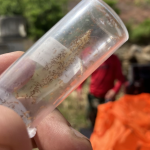HONOLULU – October is Stop the Ant Month in Hawaiʻi and a multi-agency effort throughout the month will encourage residents to collect and submit ants from their properties to help detect and control the spread of invasive little fire ants (LFA) and other harmful pest ants that may be new to the state.
Invasive Species
JOSH GREEN, M.D. GOVERNOR DAWN CHANG CHAIRPERSON COMMUNITY MEMBERS HONORED DURING INVASIVE SPECIES AWARENESS MONTH Governor and State Leaders Celebrate Contributions that Protect Hawaiʻi from Invasive Species HONOLULU – As ...
Read More 5/28/25 – COMMUNITY MEMBERS HONORED DURING INVASIVE SPECIES AWARENESS MONTH
HONOLULU — The Ka‘iwa Ridge Trail, popularly known as the Lanikai Pillbox Trail, will close for Little Fire Ant (LFA) treatment from 6-10 a.m. tomorrow, May 7. Several agencies including the DLNR Division of Forestry and Wildlife (DOFAW), the O‘ahu Invasive Species Committee (OISC), and the Hawai‘i Department of Agriculture are partnering in the effort to control LFA at this location.
JOSH GREEN, M.D. GOVERNOR DAWN CHANG CHAIRPERSON PRIVATE LANDOWNERS ON MAUI NUI SOUGHT TO ASSIST AXIS DEER CONTROL KAHULUI, MAUI – Axis deer continue to negatively impact Maui Nui forested ...
Read More 5/5/25 – PRIVATE LANDOWNERS ON MAUI NUI SOUGHT TO ASSIST AXIS DEER CONTROL
HONOLULU – May is Hawaiʻi Invasive Species Awareness Month (HISAM). The campaign is in its eighth year, raising awareness of the serious threats invasive species pose to all aspects of life in Hawaiʻi and celebrating the work of those who help protect our islands.
JOSH GREEN, M.D. GOVERNOR DAWN CHANG CHAIRPERSON VOLUNTEERS ASSIST COQUI FROG CONTROL EFFORTS ON O‘AHU HONOLULU – During every Thursday evening get togethers in Waimānalo, people gather at sunset ...
Read More 2/10/25 – VOLUNTEERS ASSIST COQUI FROG CONTROL EFFORTS ON O‘AHU
JOSH GREEN, M.D. GOVERNOR DAWN CHANG CHAIRPERSON FOR IMMEDIATE RELEASE October 1, 2024 OCTOBER IS “STOP THE ANT MONTH” Hawaiʻi residents can help stop the spread of invasive ants ...
Read More 10/1/24 – OCTOBER IS “STOP THE ANT MONTH”
(HONOLULU) – Invasive coqui frogs have been found at higher elevations than previous infestations on Oʻahu. The Department of Agriculture confirmed in June, following a report from a citizen, the distinctive chirp of the coqui roughly 200 meters below the summit of Kuliʻouʻou Ridge Trail on the leeward side of the mountains. Surveys were subsequently performed by the DLNR Division of Forestry and Wildlife (DOFAW), and the Oʻahu Invasive Species Committee (OISC).
(HONOLULU) – Today marks the beginning of Hawaiʻi Invasive Species Awareness Month (HISAM), an annual campaign to prevent and minimize the impacts of invasive species and highlight the positive steps being taken to protect our islands.
HONOLULU — The Hawaiʻi Department of Land and Natural Resources (DLNR) and U.S. Fish and Wildlife Service (USFWS) are one step closer to protecting forest birds from mosquito-borne diseases in key high-elevation native forest bird habitat on Kauaʻi, with their proposal to employ Incompatible Insect Technique (IIT) to reduce mosquito populations. A jointly prepared Environmental Assessment (EA) has been finalized and issuance of a finding of no significant impact (FONSI) at the state and federal levels.









